The Ultimate Guide to Incentive Marketing
Whether you’re on a mission to secure more social media followers or subscribers, or something more tangible like more app downloads, leads, or sales — incentive marketing is for you.
Incentive marketing offers up the opportunity to not only drive business through incentivised promotions, like competitions offering serious cash, but also to reposition your brand. With incentive marketing, you can engage on a new level with your target audience, and have some serious fun growing your brand while you’re at it.
You’re probably wondering what incentive marketing even is. We’ve put together this guide to run you through it all and how it works. You’ll get familiar with some new incentive marketing concepts and discover how different competition and game styles can be adapted to suit your business.
But most importantly, you’ll discover how you can encourage exponential growth in your brand and use specialist prize insurance to leverage a modest budget. Yep, insurance. Don’t worry, we’ll get to that.
Here’s how incentive marketing works
Incentive marketing is all around us. Everyday offers in our local communities — the kind displayed on the local butcher’s blackboard, through to large, million-dollar brand campaigns — all of which are designed to powerfully grab your attention.
McDonald’s infamous ‘Monopoly’ and Subway’s ‘Sink A Sub’ campaign are perhaps two of the best known recent promotional examples. They’re attention-grabbing marketing campaigns that incentivise sales by giving customers a chance to win something.
Of course, these are significant brands and are obviously pretty large-scale examples of incentive marketing perfection, but the techniques are available to all brands — great and small.
By choosing when and how the promotion is run, brands can essentially control when, where and how their customers engage with them.
Not every business that adopts incentive marketing will be working towards the same endgame. There are a whole bunch of different incentives for incentive marketing (see what we did there?).
It might be for sales — like McDonald’s Monopoly, where sales are driven up so customers can get their hands on the tickets.
Sometimes it’s for data capture, referrals, and in-app product reviews — think campaigns based on “Give us your feedback for a chance to WIN”.
Sometimes, it’s even just for engagement on social media.
Regardless, it always comes back to getting your audience’s attention and retaining it for long enough to have some kind of positive interaction with them. Whether that’s a social media follow, a form filled in, or a purchase.
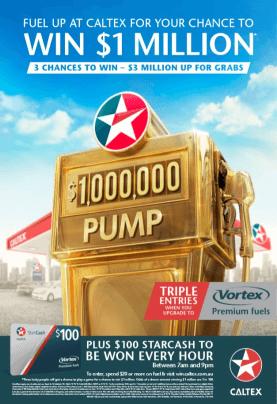

Don’t have a multi-million-dollar marketing budget?
You don’t?! Nah, neither do we. And actually, we’ll let you in on a little secret — most of us don’t. Yeah, even those international, multi-million dollar companies don’t actually have that kind of cash lying around.
The little-known industry secret behind it all? Insurance. In fact, that’s the whole point of Spoke Insure — we’re the team ready to handle the risk for you, through prize insurance. We’ll run you through all the tricks of the trade.
But first, let’s take a look at a few more examples of brand promotions.
Tip the scale of value to your potential customers. As in, make them an offer they can’t refuse.
To effectively grab the attention of your target audience, you need to make them an offer they can’t refuse.
It’s all about wowing them and stirring a real fear of missing out in them. It’s about providing something that outweighs the customer’s perceived cost of doing business with you.
In other words, you need to tip the scale of value in favour of the customer. It’s about making the prize or the offer a no brainer for them to accept.

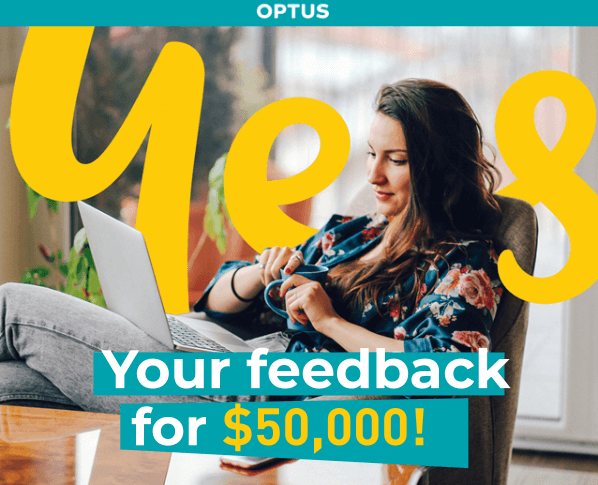
The first image (an example only, based on a brand everyone knows) offers a call to action that isn’t really designed to motivate its audience. They’re asking for the customer’s time with no incentive to be seen. Why would the customer invest five, maybe even 10 minutes in leaving feedback? What’s in it for them? The second image offers an incentive. Yeah, you might have to invest five to 10 minutes of your time, but it’s for a chance to win $50,000, and in cash — the preferred way to win.
In this example, you need to consider how much the customer’s time is worth. Would a $500 cash prize stir the same emotion? Probably not. It’s a chance to win the $500 and this is probably offered to every Optus customer in Australia.
Consider the weight of the incentive against the weight of completing the task, to determine the level of value you need to smash any objection into smithereens.
Let’s take a look at another example. This time, Signarama is offering a chance to win one of five car wraps, valued at $3,000 each. The customer needs to spend $500 to go into the draw.
That’s a sixth of the prize required to invest and it’s a tax-deductible investment for the customer’s business already.
As well as that, Signarama will then need to complete $3,000 of work for free, five times over — that’s $15,000. They’d need at least 30 people to enter the competition to break even.

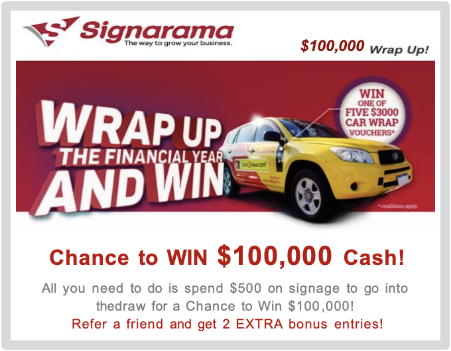
Now, a modified version of the competition. Instead of those five free products, this time it’s one top prize of $100,000. Now, the customer is spending $500 as an investment in their business and getting a crack at a big win of $100,000.
The customer is incentivised even further in this modification of the competition, with the offer of two bonus entries when the customer refers a friend.
The first iteration of the competition would cost the business $15,000, so what will it cost for this new one? Just $3,500. That’s $11,500 savings and a far better promotion, which is sure to outperform the first.
You might be wondering where the $3,500 comes from. That’s a ballpark figure for the prize insurance policy they’d need to pull off the competition.
Let’s look at the stats
1 IN 3
Consumers are more likely to buy a product or service if there’s a chance to win a prize.
$600M
Is estimated to be spent on sales promotions in Australia each year.
78%
Of the adult population in Australia entered a promotion in the past 12 months.
ConsumerTrackTM Research provided by IMI International.
Identify & Qualify Your Target Market with the Glow in the Dark Technique
What about a competition that only attracts entries from people who are unmistakably your target audience? This impressive marketing strategy is what we call the “glow in the dark” technique.
The glow in the dark technique sees you run a competition that subsequently gets potential customers who fit your exact target to market to literally put their hand up for your product or service.
But how?! Well, you offer a prize to the person who best fits your target market. If you’re selling furniture, you can offer a free furniture package to the person with the worst couch. A web design company could offer a free website to the company with the worst site. You get the idea.
You clearly define a competition – like one of the examples below – that is designed to have your ideal target market present itself to you.
These are usually pretty simple too. You just have to be able to fund the prize comfortably and you’ll receive a foolproof list of leads who already know they need your service.
Then, you can offer that list of leads a limited-time-only deal on your product as a ‘thank you for entering’, to encourage them to still spend with you.
Here are some really fun examples of the glow in the dark technique:
Business Example | Competition Example
Gardening Services | Sydney’s Most Overgrown Garden Competition
Pool Cleaning & Maintenance | Australia’s Dirtiest Pool Competition
Fencing Company | Queensland’s Ugliest Fence Competition
Furniture Store | Victoria’s Worst Couch Competition
Building & Renovation | Australia’s Most Run-Down Office Space Competition
Carpet Store | Brisbane’s Most Worn-Out Carpet Competition
Jewellery Store | Perth’s Most Elaborate Marriage Proposal
Website / App Design | Australia’s Worst Website or App Competition
So, how can you run these kinds of incentive marketing competitions with a modest marketing budget?
Have you ever looked at those massive promotional competitions like McDonald’s Monopoly and wondered, “How can they possibly afford that?!” Through prize insurance, of course.
It’s a bit of an industry secret and one that can result in serious value for your business. These campaigns are bankrolled by insurance. Yep, you simply take out a specialist prize insurance policy where you pay a premium in order to be covered in the case someone does win that high-value prize.
Of course, we, the insurance company, know what we’re doing. The prize can’t be won on every occasion — just like how you don’t win each time you visit the casino. So, we’ll cover the risk.
Yeah, we have people in our team who are good at math and they let us know exactly what the risk is and how that translates into your prize insurance policy.
The higher the chance of winning, the higher the premium. The lower the chance, the lower the premium. And then the value of the prize matters too.
We don’t need the math team to tell you that a $1,000,000 prize will cost more to insure than a $100,000 prize.
The prize insurance then means you, personally, have no risk. You pay your premium to run your competition, then you watch the leads roll in from your killer promotion.
These premiums can also be scaled to fit your budget. So, it’s always worth having a chat with a specialist prize insurance broker ahead of planning your competition. Pssst. We have a free 30-minute incentive marketing consultation you can book at the end of this article.
Okay, so that’s how brands are bankrolling these competitions. Now, how can you jump on board?
Types of incentive marketing promotions
Wondering about the different kinds of incentive marketing promotions you can run, and what the pros and cons of each are? Our promotions guide is for you.
Book your free 30-minute consultation
Book your 30-minute free incentive marketing consultation to discover what your business could do with the help of prize insurance.

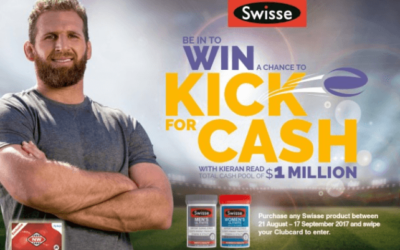
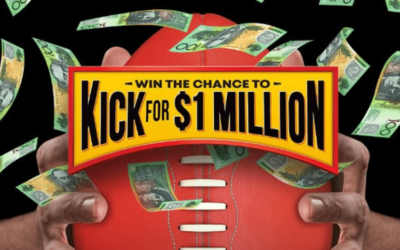
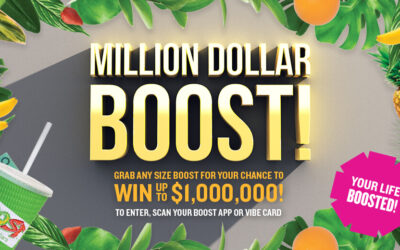
0 Comments